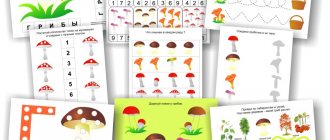Integrated lesson of history and MHC in 5th grade
Lesson type: Lesson on studying and initially consolidating new knowledge.
Lesson form: Combined lesson using a Microsoft Power Point presentation and elements of independent work by students.
Lesson objectives:
Educational:
— deepen and expand understanding of the Bible as a historical source;
- identify the reasons for the emergence of monotheism;
- introduce biblical stories;
— consolidate knowledge on the topic: “Phoenician sailors.”
Educational:
- develop the ability to clearly formulate your thoughts orally and in writing, intensify mental activity;
— improve skills in working with chronology;
- develop speech, expanding your vocabulary with new terms, reading text aloud.
Educational:
- cultivate a culture of speech and behavior,
- learn to give a moral assessment of actions.
- get acquainted with universal human moral principles.
Basic concepts and terms: nomads, the Bible, the Old Testament, commandments, monotheism, covenant, tablets.
Equipment:
Computer class, presentation, textbook Vigasin A.A., Goder G.I., Sventsitskaya I.S. Ancient world history. 5th grade. - M.: Education, 2007
Lesson summary "Bible Tales". 5th grade
Open history lesson in 5th grade
Lesson topic
:
Biblical tales
History teacher Vaganova Irina Vitalievna
Municipal educational institution Kolenovskaya secondary school, Rostov MR
lesson - with elements of laboratory and practical work with the text of the Bible
Lesson Objectives
:
- introduce students to the structure of the Bible and the main biblical stories;
- develop the ability to use the text of the Bible;
- learn to analyze document texts and highlight logical parts in the text read;
- develop speech by expanding your vocabulary with new terms and reading text aloud.
Terms and concepts
: Bible, covenant, Canaan, exodus, Trumpet of Jericho, Philistines, Judaism, monotheism, tablets, Ark of the Covenant.
Lesson equipment
:
1) The Bible for children and other biblical texts;
2) paintings by artists on biblical subjects.
Lesson Plan
:
- The Bible is the sacred book of millions of people.
- Joseph's story.
- Moses. Exodus of the Israelites from Egypt. Ten Commandments.
- Worship of the ancient Jews. Prophets.
- Conquest of the land of Canaan. Samson and Delilah.
- Kings (Saul, David, Solomon). David and Goliath. Solomon's Judgment.
- Consolidation and testing of knowledge.
Sacred history.
The homework for the previous lesson is individual: reading and retelling biblical stories. Each student received a “sheet of wanderings,” which lists the main plots and heroes of Old Testament history. On this sheet, children, together with the teacher, distribute what exactly each student is preparing for the lesson. This work in itself is a preliminary systematization of the material.
This sheet looks like this:
Creation of the world Adam and Eve. The Fall. Flood. Noah's Ark. Tower of Babel. Abraham. Sacrifice of Isaac. Egypt. Moses on Mount Sinai. David and Saul. Solomon's Judgment.
Teacher:
Today we will talk about the Bible. This is the only book that is simply called “book,” which is how the word “Bible” is translated. Its secrets can be comprehended only by believing. The Apostle Paul said that “faith is the evidence of things not seen and the substance of things hoped for.” We will try to believe the biblical stories and will not question all these sometimes fabulous and implausible stories for modern people. Let's try to understand why they have worried the world for thousands of years. (XII century BC - II century AD) - a collection of books that are considered sacred in Christianity and Judaism. Consists of 66 books, divided into two parts: the Old Testament and the New Testament.
Composition of the Bible: works of various genres:
The New Testament is the life and teachings of Jesus Christ and his disciples. The book begins with the Gospel of Matthew and ends with the Revelation of John the Theologian, which contains the Christian idea of the end of the world.
Bible
translated from Greek means “Books”, that is, a whole library.
So, the Bible is the speech of God to people, and also the story of how people listened (or did not listen) to their Creator. This dialogue lasted one and a half thousand years.
The word "covenant" means "agreement." (Entry in the dictionary in a notebook). This means that there were Old and New “agreements”. Who agreed and what did they agree on?
Through the most worthy people of different times, God made covenants - agreements, alliances with people, giving them promises - promises of salvation from the power of evil. The Old Testament speaks of four such unions (note the study board where the following list is posted):
Adam Noah Abraham Moses
Let's write down these names. In return, the people promised not to sin and to obey.
The first covenant was broken by Adam.
Working with the text of the children's Bible. (P. 20 “The Expulsion of Adam and Eve from Paradise”)
Questions: 1. Find in the text why God expelled Adam and Eve from paradise?
(they disobeyed God)
2. How did they disobey God? (violated the prohibition not to eat fruit from the tree
goodness and knowledge)
3. what God’s punishment awaited Eve and Adam if they ate fruit from the tree
knowledge? (they will die)
4. Who decided to destroy Adam and Eve? (Satan in the image of the Serpent - the tempter)
5. Who speaks the truth: the Serpent?, saying that a person will not die by eating fruits or
God? (both are right, since by breaking the covenant, the person died spiritually)
Teacher
: Many centuries passed, and many people appeared on earth - the descendants of Adam and Eve. At first, many of them feared God and served him, but gradually they all began to act against the will of God and became immoral and deceitful. What happened next? Sergey Golubev will tell us about this.
The dove is a symbol of good news, salvation and prosperity.
In which ancient work have we already encountered the myth of the flood?
The covenant that God made with the righteous Noah made it possible to revive humanity after the Flood
The story of Abraham is the next point on our journey.
The Abrahamic Covenant marked the emergence of God's chosen people (the Jews).
In ancient times, Jewish tribes roamed Northern Arabia and were engaged in cattle breeding. The Bible traces the origin of the Jewish people to Abraham, a native of the city of Ur in Mesopotamia.
Working with the text of the children's Bible "Abraham". P. 34.
Questions:
- How is the name "Abraham" translated from Hebrew? (father of many nations)
- What covenant did God make with Araam? (to go to the “promised” land and give rise to a great nation)
Abraham's son Isaac had a younger son, Jacob. God gave him a second name - Israel. Later, this name began to denote the entire people and the modern state. His son Isaac and grandson Jacob (second name Israel - “God’s warrior”) are considered the ancestors of the Jewish people. From the sons of Jacob came 12 branches of the Jewish tribe. Jacob loved Joseph more than anyone. Joseph became a participant in exciting events. But he will tell us about this himself. (student Sergey Vlasov)
Questions to the text.
About Joseph:
- Why did the brothers hate Joseph? Do you think their anger was justified?
- How did Joseph go from being a slave to becoming a ruler in Egypt? What personal qualities helped him in this?
- Do you think Joseph was right to forgive his brothers?
Teacher:
Centuries passed, and at times the faith of Abraham's descendants weakened. Therefore, the Jews found themselves in Egypt, practically in the position of slaves. Further events are associated with the name of the greatest prophet Moses.
Prophets played an important role in the life of Jewish society. Many ancient peoples had prophets - people who predicted the future. But only among the Jews they became not just predictors of the future, but, first of all, preachers who exposed the sins of the people and were ardent adherents of one God - Yahweh. Prophets often helped kings with advice in difficult times. The prophets were the forefather of the Jews, Abraham, and Noah, who escaped the flood. The prophet Elijah managed to call heavenly fire onto his altar. The Prophet Isaiah predicted the birth of the Savior from the Virgin Mary and the suffering of Christ. One of the most famous of them was Moses.
The floor is given to the student. (Demonstration of the painting by D. Da Volterra “Moses on Mount Sinai”).
About Moses:
- Why did the Egyptian Pharaoh order the destruction of all the babies of the Jewish people?
- How did Moses manage to escape?
- What task did God give Moses?
- How did Moses manage to save his people?
Teacher:
The Jews reached the Red Sea, but then the chariots of Pharaoh's warriors almost overtook them.
The Jews rushed into the sea, and its waters, as the Bible says, parted before them. The fugitives walked along the bottom of the sea. Pharaoh's warriors rushed after them. But the sea waves closed over them and swallowed up their pursuers. The Jews ended up on the Sinai Peninsula. They could quickly reach their homeland. However, Moses led them through the desert for 40 years so that they would forget their captivity and slavery, so that their souls would become free. The Bible says that God saved the Jews from famine by sending them manna from heaven. The Jews settled at Mount Sinai. Moses ascended a mountain that was smoking and shaking with thunder. On Mount Sinai, Moses received stone tablets from God
. The 10 commandments of God were inscribed on the tablets. These are the commandments. The covenant with Moses returned the Jewish people to the true path and gave them the laws of righteous life - the Ten Commandments.
Working with the text of the children's Bible: p. 102. "Ten Commandments"
Ten Commandments:
- the people must worship one God;
- one should not repeat the name of God unless absolutely necessary;
- there is no need to create idols for yourself;
- work for six days, and rest on the seventh;
- Honor your father and your mother;
- dont kill;
- Thou shalt not commit adultery;
- don't steal;
- do not bear false testimony;
- do not covet anything that your neighbor has
Question: Why do people still follow these commandments today?
(Write on the board and in notebooks) A commandment is a sacred law that cannot be broken.
5.
Conquest of the land of Canaan (commented reading of a text excerpt from the paragraph).
Questions:
- Why did the Jews have to reconquer their lands?
- Which city was the main obstacle for the Jews?
- Why did the walls of Jericho collapse?
- What does the expression “Trumpet of Jericho” mean?
Assignment: reading the document - Samson and Delilah.
6. Teacher: After a series of Israeli raids on Palestine, the Canaanites living there were dealt a crushing blow. The Jews managed to settle in Palestine. They did not yet have common power. In the face of any danger, the tribes obeyed the chosen leader - the judge. It was believed that such a leader was helped by God. Jews believe that there is only one true God - Yahweh, who created the world and man. It was the first monotheistic religion. And the religion of the Jews is Judaism.
At the end of the 11th century BC, the leaders of the tribes first chose Saul from the tribe of Benjamin as king.
Questions:
- Name the kings of the Kingdom of Israel and Judah. (Saul, David, Solomon)
- What brought David fame and recognition from the people? (Student’s story “David and Goliath”). Danilova Dasha.
- Which king was famous for his extraordinary wisdom? (Working with the source. P. 176. “The Judgment of Solomon”).
Make up a story based on the picture “The Judgment of King Solomon”
— One day they came to two and brought it.
- Each of them claimed
- To find out which of them is lying and which is right, Solomon suggested
- Then one of the women said
- The other one screamed
- So Solomon found out
4.What contributed to Israel's prosperity during Solomon's reign?
5. What two parts did the Kingdom of Israel split into and why?
Working with the map.
Reinforcing the material learned
Quiz
- The people from whom the word "Palestine" comes.
- The first woman, the foremother of all humanity.
- The first man, the progenitor of humanity.
- Belief in one God
- Biblical character who managed to save Jews from Egyptian slavery.
- Capital of the Kingdom of Israel
- Biblical hero with extreme strength
- The ancestor of the Jewish people in biblical mythology
- Holy book of Jews and Christians
- Son of King David, famous for his wisdom
- A good and God-fearing man saved by God during the Flood
- Stone tablets for recording divine commandments
- A treaty concluded, according to the Bible, between the ancient Jews and God
- Biblical beauty, Samson's lover
Homework:
Using these words, compose a story “Through the Pages of the Bible”: Abraham, Canaan, Palestine, Jacob, Joseph, Moses, Covenant, Yahweh, tablets, exodus, captivity, Philistines, Jericho, Samson, David, Solomon, Israel, Judah.





